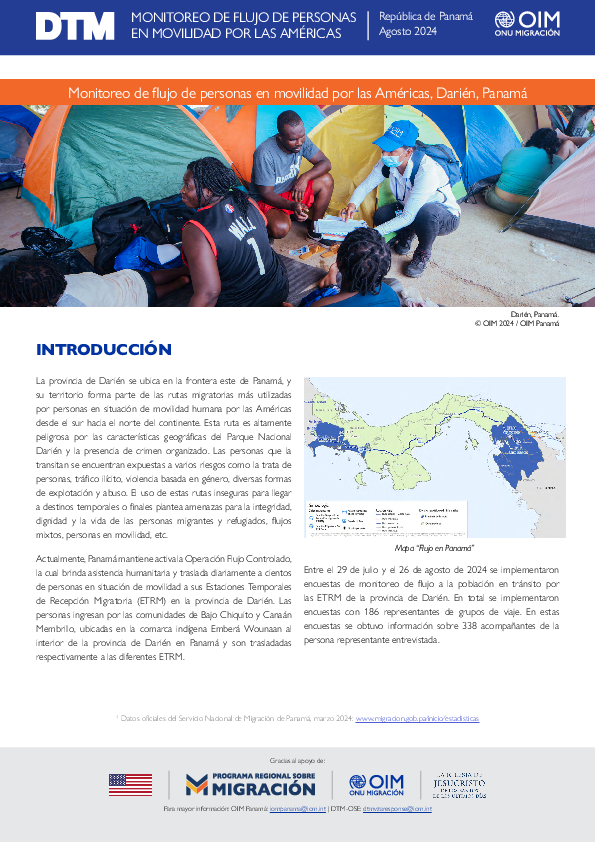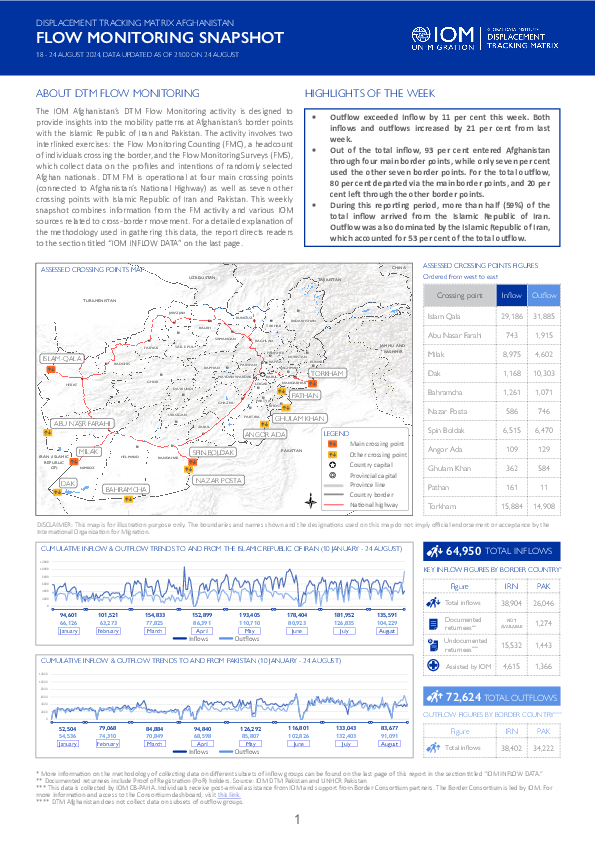-
Countries
-
Data and Analysis
-
Special Focus
-
Crisis Responses
Flow Monitoring Survey

Contact
iomguatemala@iom.int
Language
English
Location
Guatemala
Period Covered
Jun 01 2024
Jun 30 2024
Activity
- Survey
- Flow Monitoring Survey
- Flow Monitoring
- Flow Monitoring Registry
In June 2024, 20 807 movements were observed in Guatemala (13% children) and 247 individuals were surveyed. The number of observed movements decreased by 19 per cent from May 2024 (25 550). This is a result of the increase in patrols along the Mexico–Guatemala border as well as increased insecurity in some parts of Guatemala, pushing migrants to use alternative routes.46 per cent of the total number of movements came from the Bolivarian Republic of Venezuela.
91 per cent of the surveyed population noted that the United States of America was their intended destination. Since 2022, migratory flows through the Latin America and Caribbean region have increased significantly, with record levels of persons crossing the perilous jungle of the Darién National Park from Colombia into Panama. The in-transit flows tracked in Guatemala have mirrored these regional migration trends.

Contact
iomguatemala@iom.int
Language
English
Location
Guatemala
Period Covered
May 01 2024
May 31 2024
Activity
- Survey
- Flow Monitoring Survey
- Flow Monitoring
- Flow Monitoring Registry
In May 2024, 25 550 movements were observed in Guatemala (15% children) and 385 individuals were surveyed.1 The number of observed movements increasd by 20 per cent from April 2024 (21 339), as the number of travellers from Central America transiting Guatemela, as well as the upcoming elections in Venezuela. 48 per cent of the total number of movements originated from the Bolivarian Republic of Venezuela. The main intended destination was the United States of America (94%).
Since 2022, migratory flows through the Latin America and Caribbean region have increased significantly, with record levels of persons crossing the perilous jungle of the Darién National Park from Colombia into Panama. The in-transit flows tracked in Guatemala have mirrored these regional migration trends.

Contact
DTMAfghanistan@iom.int
Language
English
Location
Afghanistan
Period Covered
Sep 15 2024
Sep 21 2024
Activity
- Survey
- Flow Monitoring Survey
- Flow Monitoring
DTM Flow Monitoring, conducted by IOM Afghanistan, is designed to provide insights into the mobility patterns at Afghanistan’s border points with the Islamic Republic of Iran and Pakistan. This activity involves two interlinked exercises: Flow Monitoring Counting (FMC), which monitors the number of movements across the border, and Flow Monitoring Surveys (FMS), which collect data on the profiles of randomly selected Afghan nationals crossing the border including documentation held, reasons for travel, and the intended period of stay/ travel. It is important to note that DTM collects information on total movements at a given border point, not the number of unique individuals entering or leaving the country. As a result, if one individual both left and re-entered Afghanistan during the reporting period, this would count as one outflow movement and one inflow movement. Movements can be attributed to a wide variety of reasons, including returnees coming back to Afghanistan after living abroad, people visiting family, deportees, those travelling for economic reasons, medical patients, students, or Afghans moving abroad for different reasons. Circular movements, which include those who frequently and regularly travel back and forth across the border for trade and other reasons, are also common. This monitoring offers a clear picture of population movements in and out of the country.
DTM FM is operational at four main crossing points (connected to Afghanistan’s National Highway) as well as six other crossing points with Islamic Republic of Iran and Pakistan. This weekly snapshot combines information from the FM activity and various IOM sources related to cross-border movement. For a detailed explanation of the methodology used in gathering this data, the report directs readers to the section titled “IOM INFLOW DATA” on the last page.

Contact
DTMAfghanistan@iom.int
Language
English
Location
Afghanistan
Period Covered
Sep 08 2024
Sep 14 2024
Activity
- Survey
- Flow Monitoring Survey
- Flow Monitoring
DTM Flow Monitoring, conducted by IOM Afghanistan, is designed to provide insights into the mobility patterns at Afghanistan’s border points with the Islamic Republic of Iran and Pakistan. This activity involves two interlinked exercises: Flow Monitoring Counting (FMC), which monitors the number of movements across the border, and Flow Monitoring Surveys (FMS), which collect data on the profiles of randomly selected Afghan nationals crossing the border including documentation held, reasons for travel, and the intended period of stay/ travel. It is important to note that DTM collects information on total movements at a given border point, not the number of unique individuals entering or leaving the country. As a result, if one individual both left and re-entered Afghanistan during the reporting period, this would count as one outflow movement and one inflow movement. Movements can be attributed to a wide variety of reasons, including returnees coming back to Afghanistan after living abroad, people visiting family, deportees, those travelling for economic reasons, medical patients, students, or Afghans moving abroad for different reasons. Circular movements, which include those who frequently and regularly travel back and forth across the border for trade and other reasons, are also common. This monitoring offers a clear picture of population movements in and out of the country.
DTM FM is operational at four main crossing points (connected to Afghanistan’s National Highway) as well as six other crossing points with Islamic Republic of Iran and Pakistan. This weekly snapshot combines information from the FM activity and various IOM sources related to cross-border movement. For a detailed explanation of the methodology used in gathering this data, the report directs readers to the section titled “IOM INFLOW DATA” on the last page.

Contact
DTMAfghanistan@iom.int
Language
English
Location
Afghanistan
Period Covered
Sep 01 2024
Sep 07 2024
Activity
- Survey
- Flow Monitoring Survey
- Flow Monitoring
DTM Flow Monitoring, conducted by IOM Afghanistan, is designed to provide insights into the mobility patterns at Afghanistan’s border points with the Islamic Republic of Iran and Pakistan. This activity involves two interlinked exercises: Flow Monitoring Counting (FMC), which monitors the number of movements across the border, and Flow Monitoring Surveys (FMS), which collect data on the profiles of randomly selected Afghan nationals crossing the border including documentation held, reasons for travel, and the intended period of stay/ travel. It is important to note that DTM collects information on total movements at a given border point, not the number of unique individuals entering or leaving the country. As a result, if one individual both left and re-entered Afghanistan during the reporting period, this would count as one outflow movement and one inflow movement. Movements can be attributed to a wide variety of reasons, including returnees coming back to Afghanistan after living abroad, people visiting family, deportees, those travelling for economic reasons, medical patients, students, or Afghans moving abroad for different reasons. Circular movements, which include those who frequently and regularly travel back and forth across the border for trade and other reasons, are also common. This monitoring offers a clear picture of population movements in and out of the country.
DTM FM is operational at four main crossing points (connected to Afghanistan’s National Highway) as well as six other crossing points with Islamic Republic of Iran and Pakistan. This weekly snapshot combines information from the FM activity and various IOM sources related to cross-border movement. For a detailed explanation of the methodology used in gathering this data, the report directs readers to the section titled “IOM INFLOW DATA” on the last page.

Contact
DTMAfghanistan@iom.int
Language
English
Location
Afghanistan
Period Covered
Aug 25 2024
Aug 31 2024
Activity
- Survey
- Flow Monitoring Survey
- Flow Monitoring
The IOM Afghanistan’s DTM Flow Monitoring activity is designed to provide insights into the mobility patterns at Afghanistan’s border points with the Islamic Republic of Iran and Pakistan. The activity involves two interlinked exercises: the Flow Monitoring Counting (FMC), a headcount of individuals crossing the border, and the Flow Monitoring Surveys (FMS), which collect data on the profiles and intentions of randomly selected Afghan nationals. DTM FM is operational at four main crossing points (connected to Afghanistan’s National Highway) as well as six other crossing points with Islamic Republic of Iran and Pakistan. This weekly snapshot combines information from the FM activity and various IOM sources related to cross-border movement. For a detailed explanation of the methodology used in gathering this data, the report directs readers to the section titled “IOM INFLOW DATA” on the last page.

Contact
DTM Somalia, IOMSomaliaDTM@iom.int
Language
English
Location
Somalia
Period Covered
Jul 01 2024
Jul 31 2024
Activity
- Survey
- Flow Monitoring Survey
- Flow Monitoring
- Flow Monitoring Registry
A total of 24,886 movements were observed in July 2024, representing a 10 per cent increase compared to June 2024, when 22,559 movements were observed during this period. Comparing July 2024 with June 2024, Cabudwaaq (+28%), Doolow (+21%), Buuhoodle (+8%) and Lowyacado (+8%) FMPs recorded an increase in movements while Dhobley (-15%), Harirad (-9%) and Bossaso (-3%) FMPs recorded a decrease in movements.
Doolow (37%), Cabudwaaq (20%), and Dhobley (17%) FMPs recorded the highest numbers of incoming movements, while Doolow (64%), Bossaso (21%) and Dhobley (7%) recorded the highest numbers of outgoing movements for July 2024.

Contact
Idiam Osorio, iosorio@iom.int
Language
English
Location
Panama
Period Covered
Jul 29 2024
Aug 26 2024
Activity
- Flow Monitoring Survey
- Flow Monitoring
Entre el 29 de julio y el 26 de agosto de 2024 se implementaron encuestas de monitoreo de flujo a la población en tránsito por las ETRM de la provincia de Darién. En total se implementaron encuestas con 186 representantes de grupos de viaje. En estas encuestas se obtuvo información sobre 338 acompañantes de la persona representante entrevistada.

Contact
Idiam Osorio, iosorio@iom.int
Language
English
Location
Panama
Period Covered
Jul 29 2024
Aug 26 2024
Activity
- Flow Monitoring Survey
- Flow Monitoring
Between July 29 and August 26, 2024, flow monitoring surveys were conducted among the population in transit in the ETRMs of the Darien province. A total of 186 people representing different travel groups were surveyed and additional information was obtained on 338 people accompanying them.

Contact
DTMAfghanistan@iom.int
Language
English
Location
Afghanistan
Period Covered
Aug 18 2024
Aug 24 2024
Activity
- Survey
- Flow Monitoring Survey
- Flow Monitoring
The IOM Afghanistan’s DTM Flow Monitoring activity is designed to provide insights into the mobility patterns at Afghanistan’s border points with the Islamic Republic of Iran and Pakistan. The activity involves two interlinked exercises: the Flow Monitoring Counting (FMC), a headcount of individuals crossing the border, and the Flow Monitoring Surveys (FMS), which collect data on the profiles and intentions of randomly selected Afghan nationals. DTM FM is operational at four main crossing points (connected to Afghanistan’s National Highway) as well as seven other crossing points with Islamic Republic of Iran and Pakistan. This weekly snapshot combines information from the FM activity and various IOM sources related to cross-border movement. For a detailed explanation of the methodology used in gathering this data, the report directs readers to the section titled “IOM INFLOW DATA” on the last page.
Pagination
- Previous page
- Page 3
- Next page
